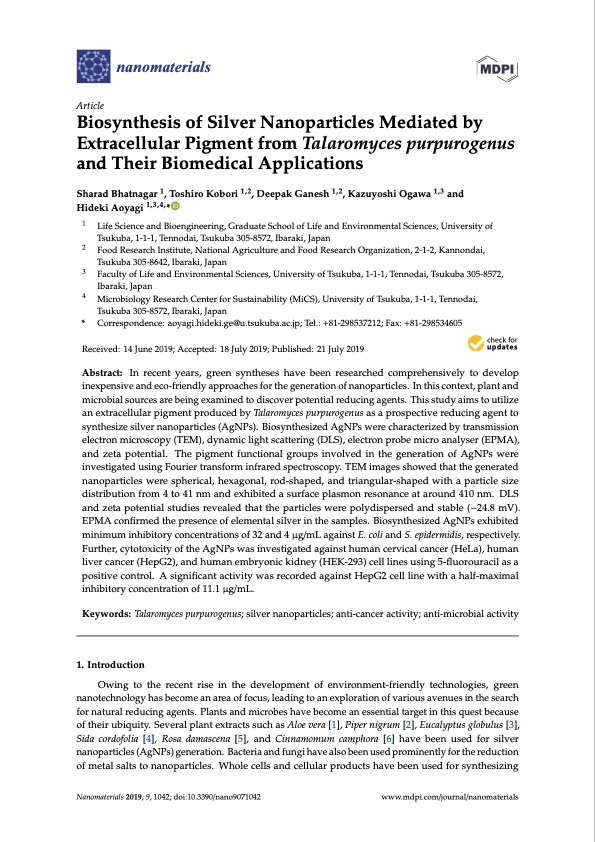
PDF Publication Title:
Text from PDF Page: 001
nanomaterials Article Biosynthesis of Silver Nanoparticles Mediated by Extracellular Pigment from Talaromyces purpurogenus and Their Biomedical Applications Sharad Bhatnagar 1, Toshiro Kobori 1,2, Deepak Ganesh 1,2, Kazuyoshi Ogawa 1,3 and Hideki Aoyagi 1,3,4,* 1 2 3 Life Science and Bioengineering, Graduate School of Life and Environmental Sciences, University of Tsukuba, 1-1-1, Tennodai, Tsukuba 305-8572, Ibaraki, Japan Food Research Institute, National Agriculture and Food Research Organization, 2-1-2, Kannondai, Tsukuba 305-8642, Ibaraki, Japan Faculty of Life and Environmental Sciences, University of Tsukuba, 1-1-1, Tennodai, Tsukuba 305-8572, Ibaraki, Japan Microbiology Research Center for Sustainability (MiCS), University of Tsukuba, 1-1-1, Tennodai, Tsukuba 305-8572, Ibaraki, Japan 4 * Correspondence: aoyagi.hideki.ge@u.tsukuba.ac.jp; Tel.: +81-298537212; Fax: +81-298534605 Received: 14 June 2019; Accepted: 18 July 2019; Published: 21 July 2019 Abstract: In recent years, green syntheses have been researched comprehensively to develop inexpensive and eco-friendly approaches for the generation of nanoparticles. In this context, plant and microbial sources are being examined to discover potential reducing agents. This study aims to utilize an extracellular pigment produced by Talaromyces purpurogenus as a prospective reducing agent to synthesize silver nanoparticles (AgNPs). Biosynthesized AgNPs were characterized by transmission electron microscopy (TEM), dynamic light scattering (DLS), electron probe micro analyser (EPMA), and zeta potential. The pigment functional groups involved in the generation of AgNPs were investigated using Fourier transform infrared spectroscopy. TEM images showed that the generated nanoparticles were spherical, hexagonal, rod-shaped, and triangular-shaped with a particle size distribution from 4 to 41 nm and exhibited a surface plasmon resonance at around 410 nm. DLS and zeta potential studies revealed that the particles were polydispersed and stable (−24.8 mV). EPMA confirmed the presence of elemental silver in the samples. Biosynthesized AgNPs exhibited minimum inhibitory concentrations of 32 and 4 μg/mL against E. coli and S. epidermidis, respectively. Further, cytotoxicity of the AgNPs was investigated against human cervical cancer (HeLa), human liver cancer (HepG2), and human embryonic kidney (HEK-293) cell lines using 5-fluorouracil as a positive control. A significant activity was recorded against HepG2 cell line with a half-maximal inhibitory concentration of 11.1 μg/mL. Keywords: Talaromyces purpurogenus; silver nanoparticles; anti-cancer activity; anti-microbial activity 1. Introduction Owing to the recent rise in the development of environment-friendly technologies, green nanotechnology has become an area of focus, leading to an exploration of various avenues in the search for natural reducing agents. Plants and microbes have become an essential target in this quest because of their ubiquity. Several plant extracts such as Aloe vera [1], Piper nigrum [2], Eucalyptus globulus [3], Sida cordofolia [4], Rosa damascena [5], and Cinnamomum camphora [6] have been used for silver nanoparticles (AgNPs) generation. Bacteria and fungi have also been used prominently for the reduction of metal salts to nanoparticles. Whole cells and cellular products have been used for synthesizing Nanomaterials 2019, 9, 1042; doi:10.3390/nano9071042 www.mdpi.com/journal/nanomaterialsPDF Image | Biosynthesis of Silver Nanoparticles Talaromyces purpurogenus

PDF Search Title:
Biosynthesis of Silver Nanoparticles Talaromyces purpurogenusOriginal File Name Searched:
nanomaterials-09-01042.pdfDIY PDF Search: Google It | Yahoo | Bing
Turbine and System Plans CAD CAM: Special for this month, any plans are $10,000 for complete Cad/Cam blueprints. License is for one build. Try before you buy a production license. More Info
Waste Heat Power Technology: Organic Rankine Cycle uses waste heat to make electricity, shaft horsepower and cooling. More Info
All Turbine and System Products: Infinity Turbine ORD systems, turbine generator sets, build plans and more to use your waste heat from 30C to 100C. More Info
CO2 Phase Change Demonstrator: CO2 goes supercritical at 30 C. This is a experimental platform which you can use to demonstrate phase change with low heat. Includes integration area for small CO2 turbine, static generator, and more. This can also be used for a GTL Gas to Liquids experimental platform. More Info
Introducing the Infinity Turbine Products Infinity Turbine develops and builds systems for making power from waste heat. It also is working on innovative strategies for storing, making, and deploying energy. More Info
Need Strategy? Use our Consulting and analyst services Infinity Turbine LLC is pleased to announce its consulting and analyst services. We have worked in the renewable energy industry as a researcher, developing sales and markets, along with may inventions and innovations. More Info
Made in USA with Global Energy Millennial Web Engine These pages were made with the Global Energy Web PDF Engine using Filemaker (Claris) software.
Infinity Turbine Developing Spinning Disc Reactor SDR or Spinning Disc Reactors reduce processing time for liquid production of Silver Nanoparticles.
| CONTACT TEL: 608-238-6001 Email: greg@infinityturbine.com | RSS | AMP |